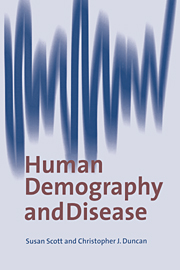Book contents
- Frontmatter
- Contents
- Preface
- Conversion table for imperial to metric units
- 1 Introduction
- 2 Tools for demography and epidemiology
- 3 Identification of population oscillations: a case study
- 4 Density-dependent control and feedback
- 5 Modelling the endogenous oscillations and predictions from timeseries analysis
- 6 Cycles in the grain price series
- 7 Interactions of exogenous cycles: a case study
- 8 Mortality crises and the effects of the price of wool
- 9 Modelling epidemics for the demographer: the dynamics of smallpox in London
- 10 Non-linear modelling of the 2-yearly epidemics of smallpox: the genesis of chaos?
- 11 Measles and whooping cough in London
- 12 Integration of the dynamics of infectious diseases with the demography of London
- 13 Smallpox in rural towns in England in the 17th and 18th centuries
- 14 Infectious diseases in England and Wales in the 19th century
- 15 Prospectives – towards a metapopulation study
- References
- Index
5 - Modelling the endogenous oscillations and predictions from timeseries analysis
Published online by Cambridge University Press: 25 January 2010
- Frontmatter
- Contents
- Preface
- Conversion table for imperial to metric units
- 1 Introduction
- 2 Tools for demography and epidemiology
- 3 Identification of population oscillations: a case study
- 4 Density-dependent control and feedback
- 5 Modelling the endogenous oscillations and predictions from timeseries analysis
- 6 Cycles in the grain price series
- 7 Interactions of exogenous cycles: a case study
- 8 Mortality crises and the effects of the price of wool
- 9 Modelling epidemics for the demographer: the dynamics of smallpox in London
- 10 Non-linear modelling of the 2-yearly epidemics of smallpox: the genesis of chaos?
- 11 Measles and whooping cough in London
- 12 Integration of the dynamics of infectious diseases with the demography of London
- 13 Smallpox in rural towns in England in the 17th and 18th centuries
- 14 Infectious diseases in England and Wales in the 19th century
- 15 Prospectives – towards a metapopulation study
- References
- Index
Summary
The endogenous oscillations in baptisms and burials in the population at Penrith described in Chapter 3 were apparently triggered by the impact of the mortality of the plague. It can be predicted that any population that is also maintained in steady-state and which suffers a major mortality crisis would display similar oscillations (see section 3.8). These oscillations may not be readily detectable in other communities; they may decay rapidly and be obscured by the noise. The response of a discrete population in steadystate to a mortality crisis will depend on the gain of the feedback and can be classified as follows in order of increasing feedback gain.
(1) Overdamped (Fig. 5.1 A); when the gain is low, the birth rate recovers slowly to the pre-plague level without any oscillations.
(2) Just underdamped (Fig. 5.IB); with increased gain, the system recovers more rapidly and a low amplitude oscillation develops but is damped out.
(3) Very underdamped (Fig. 5.1C); with more gain and little damping the response decays slowly so that there are a number of periods of the oscillation. In general the period of the oscillation will be less than in type (2).
(4) Marginally stable (Fig. 5.ID); there is a further increase in gain of the feedback and the oscillation does not decay.
(5) Unstable (Fig. 5.IE); the amplitude of the oscillations increases progressively with the very high gain.
The long wavelength cycles in baptisms and burials at Penrith during the teady-state period, 1550–1750, are believed to be of type (4), with no decay in the oscillation.
- Type
- Chapter
- Information
- Human Demography and Disease , pp. 75 - 86Publisher: Cambridge University PressPrint publication year: 1998



